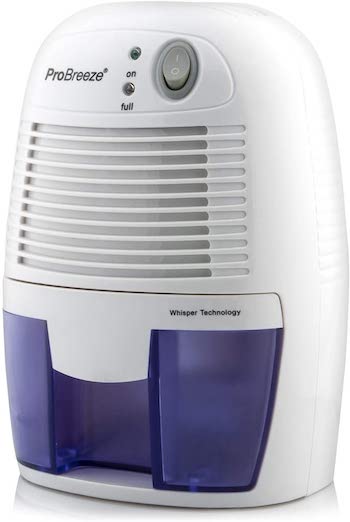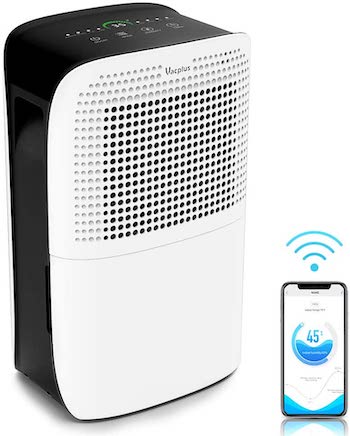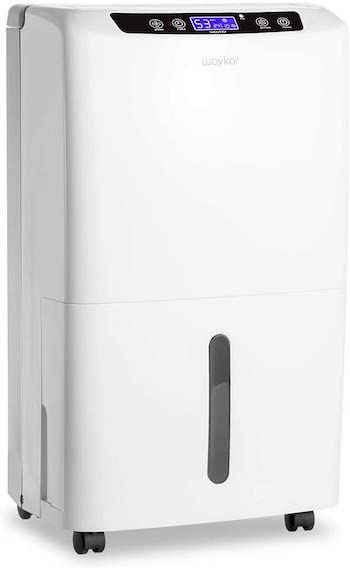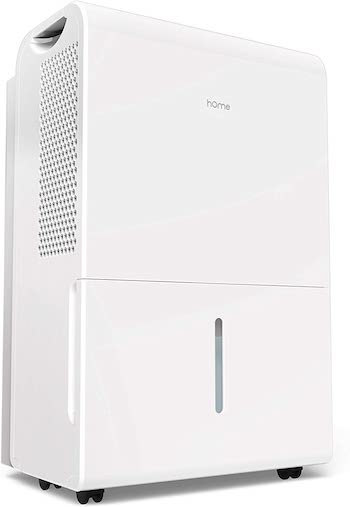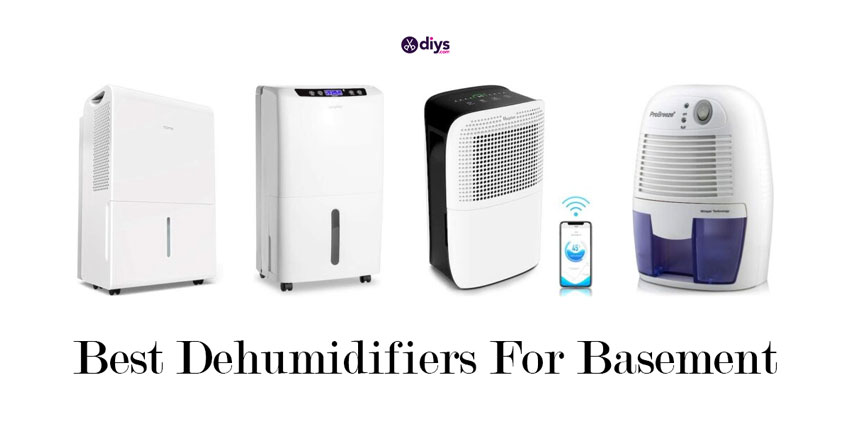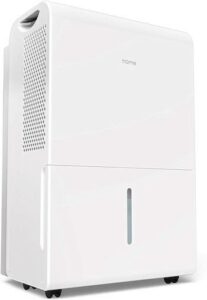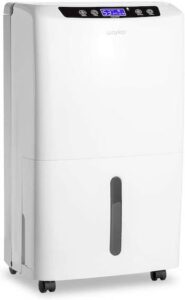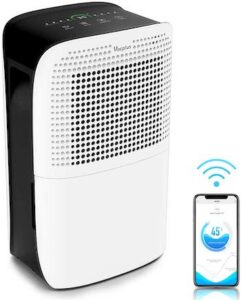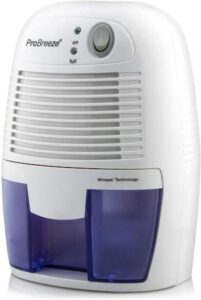The Best Dehumidifier For Basement (Reviews) in 2023
With the arrival of hot summer temperatures where we live, there has been a great increase in another weather element as well: humidity. In much the opposite was that the environment here gets very dry in the winter, the air here can also feel moist and muggy in the summer.
While this isn’t necessarily a bad thing, thereare certain impacts it can have around the yard and the home that are a little less than convenient.
On the milder end of the scale is the fact that wet hair after a shower or wet clothing hung out on the clothesline can stay damp longer and take more time than usual to dry. Along that same vein, however, there are also areas of the house that get and stay damp in very humid weather as well, but with more serious impacts.
Editor’s Choice
Control the humidity of the air down there
The biggest problem in our house in summer humidity is the atmosphere in our basement. Because it’s the kind of in-ground basemen that exists below ground level, it’s already a pretty place. It doesn’t matter how well finished, and impressive an in-ground basement looks; a very high humidity index will still have it feeling damp down there on a hot summer’s day. This might not seem like anything more than an observation, but extreme cases of humidity can actually cause moisture damage to walls, wood, and furniture in more extreme cases. We don’t want to become one of those extreme cases, of course, so we’ve been looking into the different options we have for reducing summertime humidity in our basement.
So far, the most effectiveand most cost-efficient option for handling basement humidity is to get a dehumidifier! Now, you might have heard of a humidifier before; this is a machine designed to release water into the air through evaporating steam, giving it back some of its moisture in the winter when cold temperatures sap the air of its natural moisture and leave the environment around your house (and quite likely also your skin) feeling very dry. As you might have guessed by now, adehumidifier does quite the opposite! Naturally, we wanted to make sure that we fully understood what we need, where we might find the best options, and what kinds of dehumidifiers would be most worth our money, so we decided to do some research before making any purchases.
What is a dehumidifier?
A dehumidifier is an electronic home appliance that’s on the smaller side, similar to a space heater. Its function is to reduce the level of moisture in the air in hot, damp, and humid spaces and then help maintain that reduced level so that it doesn’t climb again for as long as the machine is on (or as long as it’s been programmed to go through cycles for). This can have a range of benefits for both your health and the maintenance of and prevention of damage within your home. We’ll cover some of these perks and benefits in a moment.
How do dehumidifiers work?
Dehumidifiers actually work quite similarly to air conditioners, but the process that happens inside is ever so slightly different, causing a different output. In each machine, a fan draws the air from the room around it into the machine. Inside, the air passes over a series of coils that have been powered by the electricity involved to sit at very cool temperatures. Passing over these cold coils causes the air to cool too, which kicks off a process by which the air condenses, and the moisture that’s present in it stays there on the refrigerated surface, leaving the air a little drier. A second fan then pushes the air out. Repetition of the process cycles through the air in the room, replacing the moist air with the slightly cooler and much dryer air.
Of course, the temperatures involved in this process aren’t quite as cold as those involved in an air conditioner (unless you’ve purchased a machine that’s specifically designed to be a combination of the two appliances). Where does the moisture that clings to the cooled coils go, you ask? That’s where the removable drawer steps in. The condensed moisture turns to water that drops off the coils and is caught by the bucket. Emptying the bucket of condensed water is the only regular additional step required by you besides actually turning the machine on. Dehumidifiers are nice and easy to work with, especially given their big impact on a space.
Why do people buy dehumidifiers?
People actually purchase dehumidifiers for different reasons. Some people use them solely for comfort, while others keep them around for health reasons. Others still will run a dehumidifier in order to protect their space from increased moisture.
Dehumidifiers can:
- Reduce and maintain humidity in the air
- Clear the air of toxins and allergens thanks to filters (which has clear health benefits, especially for people with chronic respiratory issues)
- Eliminate musty odours caused by damp conditions
- Prevent conditions that will allow the growth of various mildews by removing moisture from the air
Best Dehumidifier For Basement
Are you feeling pretty determined to get a dehumidifier for your own basement now, too, but you’re still not quite ready to make a choice and settle on one particular model? Then we’d definitely suggest checking out our list below.
Below you’ll find the four best options we came across in our own search, complete with pros and cons outlined for each, just to really make sure that you can think about things nice and carefully before spending a single cent.
1. hOmeLabs 4,500 Sq. Ft Energy Star Dehumidifier for Extra Large Rooms and Basements
The first dehumidifier that caught our eye was one designed byhOmeLabs. It stood out because it was specifically built to improve the air quality and reduce humidity in very large rooms; it actually has an impressive capacity and reach of 4,500 square feet. To work hand in hand with this capability, the machine is also built with a 1.8-gallon water tank that accommodates the machine’s ability to 50 pints of water from the air a day.
The stylish machine (the company was cognizant of how clunky and unattractive many dehumidifiers look) is also built with ease in mind. It runs on a 24-hour cycle or until the water tank is full, at which points it shuts off until you can empty it. A simple button push will start the cycle all over again. Is it a little extra humid out today? Simply push the button again to activate a turbo mode that amps up the air compressor. One more push will turn the machine off. Nice and easy!
The machine is quite well-reviewed indeed, so there weren’t very many critiques of the product offered up by previous buyers. There was, however, repeated lament amongst those who missed a certain feature from their old machines, even though they acknowledge that this one actually works better. These buyers found themselves wishing that the dehumidifier had a setting that would let it stop at a certain level of humidity rather than just continuing to work until the tank is full or you turn it off manually.
Pros:
- 1.8-gallon water tank
- 4,500 square foot dehumidifying capacity for very large rooms
- Stylish design
- Simple controls and programmed system that runs for 24 hours or until the tank is full; whichever comes first
Cons:
- No setting that lets you select a program that runs until a target temperature or humidity level and then stops
2. Waykar 40 Pint Dehumidifier
If you have a slightly smaller room, but you’re living somewhere that’s much hotter and more humid, then you might benefit more from the capabilities of this machine designed and sold byWaykar. This design can dehumidify up to 2000 square feet but also has a water tank that will hold up to 5 gallons of removed water. Uniquely, however, this ergonomically designed and smoothly wheeled machine comes with an optional hose piece that you can hook up to a utility sink for automatic water draining.
In the event that you don’t have any such sink and would prefer to drain the water manually, the machine (which can be set to reach and maintain a specific level of humidity) will ignite an indicator light and switch off when the tank is full until it has been emptied. The machine also passes the air through a filter that is reusable and can be easily cleaned for better air quality.
Although most people with experience using this machine raved about its actual effectiveness, thereis one strange quirk feature that several people have pointed out in the reviews and that you’d benefit from being aware of. At first, many of these people thought their machine simply wasn’t working. In reality, they actually hadn’t opened a vent in the top back since the instruction manual doesn’t really address this necessity (of which it certainly is one). The vent is closable in order to protect the inner workings of the machine when it’s not in use (ex. if you store it away for the winter), but it does need to be opened in order for all of the different processes to work properly.
Pros:
- Sleek, easy to move physicality
- 2000 square feet capacity with a 5-gallon water tank
- Cleanable filter for better air quality
- Settings that allow chosen humidity targets but also turn the machine off when the bucket is full (if manual emptying is chosen over auto-emptying with through optional hose hookup)
Cons:
- The vent in the top back of the machine must be open for processes to work (which isn’t well explained in the manual)
3. Vacplus 50 Pints Dehumidifier with WiFi Remote for Large Rooms
If you’re looking for something with high efficiency, a sleek and space-conscious design, and a few more modern capabilities than what you’ve seen so far, then you might get along better with this dehumidifier designed and offered by Vacplus. In fact, this machine is actually classified as being “mini” for its little size versus its level of power and effectiveness. It’s capable of removing about 30 pints of water from the surrounding air per day while also creating better-filtered airflow.
The machine has extremely simple and easily laid out and labelled controls that let you set up things like chosen humidity levels, auto-shutoff response, and option auto-draining when the water tank is full thanks to a 1 m long hose. The machine is easy to move thanks to its wheels, extremely quiet while running, and it even connects wirelessly to a phone app so you can actually adjust its settings even when you’re not home, no matter where you are.
While most people were quite thrilled with this machine’s functioning, a few buyers here and there had complaints about the “continuous operation” setting. They found that, after a while, the dehumidifier started losing some of its power and effectiveness when used at this level, despite the fact that the setting was specifically designed to be used- well- constantly. The level of water cleared out into the tank became slightly less over time, so they found themselves having to turn it off here and there as though it needed a break.
Pros:
- Sleek, light design with easy-moving wheels and “miniature” size compared to many dehumidifiers of the same power
- Optional 1 m hose hookup for auto-draining water tank into a sink where possible
- Easy to control, with several well labelled and simple to find settings (including humidity level selection)
- Connects wirelessly to a phone app that will let you adjust the machine and its settings no matter where you are
Cons:
- Some users find the dehumidifier loses its strength after a lengthy time on the “continuous operation” setting
4. Pro Breeze Electric Mini Dehumidifier
Did we actually really catch your attention when we started talking about the idea of purchasing a miniature-sized dehumidifier but you’re the kind of person who always wants to make sure you’ve looked at all kinds of options rather than choosing the first promising one you see? Then here’s another small design, this time from Pro Breeze, for your consideration.
This dehumidifier is the smallest and most affordable option on our list so far. It’s lightweight, very portable, but still powerful for its appearance and price. It can remove up to 9 ounces of moisture from the air per day, but the water tank holds up to 16 ounces, meaning you don’t have to empty it every single day if you’re busy. The machine is ideal for spaces up to about 150 square feet and runs very quietly indeed, thanks to the built-in thermoelectric cooling technology. When the water tank is full, the machine will shut off automatically and switch on an LED light to inform you that the tank needs emptying.
Most previous buyers didn’t actually have any steadfast critiques for this hardy little machine. A fewdid say, however, that they found it most effective in smaller spaces, noting that the indication of 150 square feet capacity was accurate but only just barely; that truly is the widest space this tiny machine (comparison photos to lotion bottles in the reviews will show you just how little and powerful it is) can handle effectively.
Pros:
- Small, light, sleek, and portable design
- 150 square feet of reach, 16-ounce capacity water tank, and 9 ounces per day moisture removal capabilities
- Built-in thermo-electric cooling technology helps the machine run very quietly
- The machine will auto-shutoff and switch on the LED indicator when the water tank is full and needs emptying
Cons:
- Truly only has 150 square feet hard limit capacity, and no further
Types of dehumidifier
We’ve already talked a little bit about how dehumidifiers work, but that’s actually just the system forone kind of dehumidifier (albeit the most popular kind). In reality, there arethree different kinds of dehumidifiers! These are:
- Refrigerant dehumidifiers:These are the kind of dehumidifiers we spoke about earlier that used cooled coils or plates to condense the air, turn the moisture into water, and let it drip into a bucket while the air blows out dryer and cooler.
- Desiccant dehumidifiers: A desiccant dehumidifier sucks in and blows out air much like a refrigerant system, but with a different process and hardware happening inside the machine. In this case, the air is sucked in by a fan and passed through a large, constantly, and slowly turning wheel that is covered in a desiccant or some kind of specially made absorbent material (much like a filter). This desiccant absorbs the moisture in the air, holding onto it so that the air emerges on the other side of the wheel and blows back into the room much more dry. You’ll need to clean or change the desiccant or filter (depending on the kind of machine you purchase) periodically, just like you’ll have to empty the water bucket on a refrigerant dehumidifier.
- Whole-house ventilation dehumidifiers:Rather than being a small, singular appliance, this kind of dehumidifier is an actual system that you can install in your house. Although it’s actually quite simple and requires only a little bit of DIY knowledge, it’s truthfully much more time-consuming and high maintenance to set up than a simple appliance that you just unbox and plug in. This kind of dehumidifier works on a series of fans and vents like other ventilation systems do, but this time specifically built to run the air through various filters and steps. If you do the math of the power required to run this versus its effectiveness, this is actually the cheapest type of dehumidifying system to power in the long run, but most people prefer the ease and quick-setup nature of the small appliances instead.
Dehumidifier care
The needs and requirements of your dehumidifier will vary depending on the kind and brand of machine you choose to purchase. Reading the instructions manual that comes with each kind of machine is always an essential step because it prepares you for knowing how to use, care for, and clean your machine properly in order to keep it running, as well as to keep it improving the air quality of your space rather than sullying it. You’ll need to know whether your dehumidifying system uses filters, desiccants, or refrigerant coils, as well as how to empty, clean, or change its various parts after certain periods of use.
Do you know someone else who has been thinking about investing in a new dehumidifier of their own for a while now but who still feels like they could use some more guidance and information? Share this post with them, so they have all kinds of models, tips, and facts to consider before putting their money down. The more reading and recommendation searching they do, the more likely it is that they’ll make the right choice for their needs and budget!
